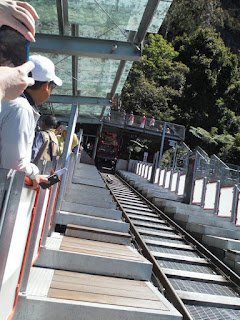However, I have friends in a couple of other Explorer groups. One of the groups invited me to join them on a guided tour of a silk farm in Bogor. Traffic into Bogor is usually OK in the mornings. It took us a little over 1.5 hours to get there. The trip back in the afternoon took over 2.5 hours.
This place is called Rumah Sutera Alam. Translated in Google Translate it means "home natural silk." It's located near the Presidential Palace#2 and the Botanical Gardens. We've driven past the palace before but so far we haven't found ourselves at the gardens. Rumah Sutera Alam is a family run business started by our guide's parents.The guide explained they refer to it as "silk for human life." The farm provides what they need for their family, they employ people and they also train people to raise silkworms.
The house and the gardens are gorgeous! I could have just sat there all day watching all of the butterflies and birds. It made me miss the various gardens we've planted over the years. This is especially true of the last house in Kentucky where we planted a very large native plant garden and enjoyed so many butterflies and birds. So pretty.
They also grow a lot of fruit on the grounds. In these shots you see dragonfruit plants.
Let's get back to talking about silk.
How does it all start? They buy silk worm "eggs" and "allow them to hatch." They buy special silk worms. Then after they rest a bit, they start feeding them. The special silk worms are fed special leaves: mulberry leaves. The special silk worms are actually fed a variety of about 6 types of mulberry leaves. They have 2 hectares (almost 5 acres) which includes the home and gardens but they grow a lot of mulberry shrubs as well. They cannot grow all the leaves they need here so they do have other fields in other locations. In the background you can see mulberry bushes. They prune them to keep them short for easy picking I suspect. A member of the group asked if they do anything with the berries. He said they did not. I figure birds will get most of them anyway. Also in this shot you can see that umbrellas are often used as a replacement for a sun bonnet! We took a walk through the mulberry fields.
Probably a shelter for the field workers? It was a nice spot in the shade for our tour.
Here are the silkworms waking up and starting to eat! Their happy temporary home is a large tray.
A closeup! Not very pretty.
The silk worms eat and eat and eat and then they spin a cocoon. Once the cocoon is done, the cocoon is captured and then it is spun into thread.
It takes 12 cocoons to make 1 thread. They undo 12 cocoons and spin them together.
Once they have individual threads, these are spun together with 5-18 threads depending on the durability and thread thickness desired.
Once they have the thread, the thread is woven into cloth. A weaver can make 3 meters of fabric per day.
We learned that not all silk worms make the same quality of silk. These two skeins are both natural color just from different silk worm varieties.
























































